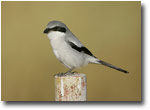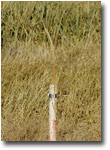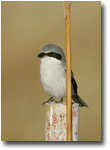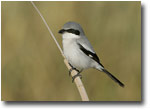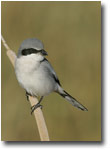During a recent visit to a local marshy area, I sat in my vehicle patiently waiting for a Northern Harrier to pass by again for another attempt at some flight shots. Much to my surprise, a normally very wary species (Loggerhead Shrike) lands on an old metal pipe just feet away from my position (Photo 1). Using a 4-wheel rolling blind has always been a favorite of bird photographers to get close to skittish birds. After popping off a few frames of this bird on the pole, I knew I had to do better. It was getting late in the morning and I needed to get home for the day. I decided I would return the next day to try to do better.
|
Arriving before sunrise the next morning, I began looking for a more photogenic perch. Wanting to be sure to choose something sturdy, I found some cattails nearby and picked one that was curved. Securing it to the pole was easy, a simple wrap of duct tape and I was in business (Photo 2). I attached it so the curve of the cattail was facing away from me, and angled some too. It was too early for the shrike to be actively hunting insects, so I moved to another spot to look for harriers again. About an hour later I figured it was warm enough for the shrike to be active and moved into position. Sure enough, the shrike was within sight, about 75 yards away and perched up on a cattail! A short time later he flew to my setup and landed… right on the pole again! (Photo 3) Uh oh… I’ve seen this behavior before - even though you give the bird another option, and maybe even a better place to hunt from, they will still go with what they have used before. After he continued on to the next perch in his hunting circle, I considered going out and modifying the perch to encourage him to land on my improvised cattail. Since his circuit through the territory would have him repeat the pole within about 10-20 minutes, I left it alone for one more try. The next time in was perfect - he landed right in the middle of the cattail and stayed for most of a minute, changing positions several times. Several dozen frames were fired off from my car window using a beanbag rest, all with a big smile on my face!
Now that he had used the perch once, I guess he decided it was a good one and only landed there. I was able to get several variations of the scene, with a 1.4X and 2X converter, horizontals and verticals, front facing and side profile poses – and not a metal pole in sight! (Photos 4 and 5) While I wouldn’t quite call this a nemesis species for me since I had successfully photographed one other cooperative bird last year, I will say that it is very satisfying to photograph a tough species in a pleasing setting, and all exactly as planned!
RS-NPN 0252
Comments on NPN bird photography articles? Send them to the editor.
Bob Steele has been involved in birding and bird photography for nearly 20 years. In the past few years, bird photography has become his passion. He is also a full-time engineer with the U.S. Navy. Bob lives in the bird-rich Kern County, California. This area is centrally located at the convergence of multiple bio-regions, giving him the opportunity to photograph many avian subjects. Visit Bob's website at www.bobsteelephoto.com.
